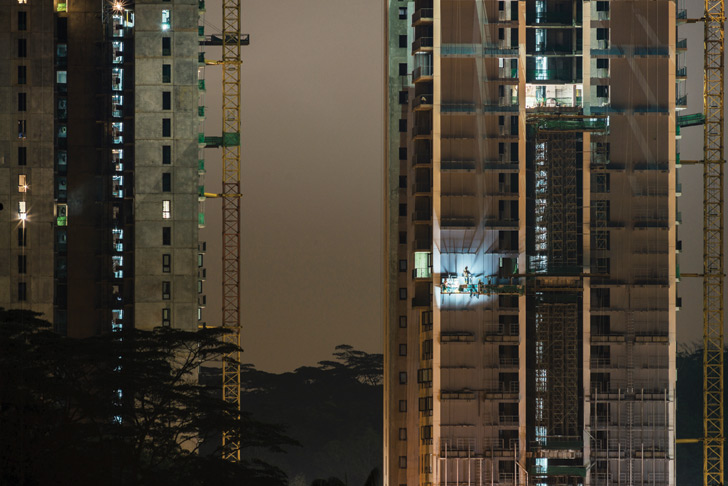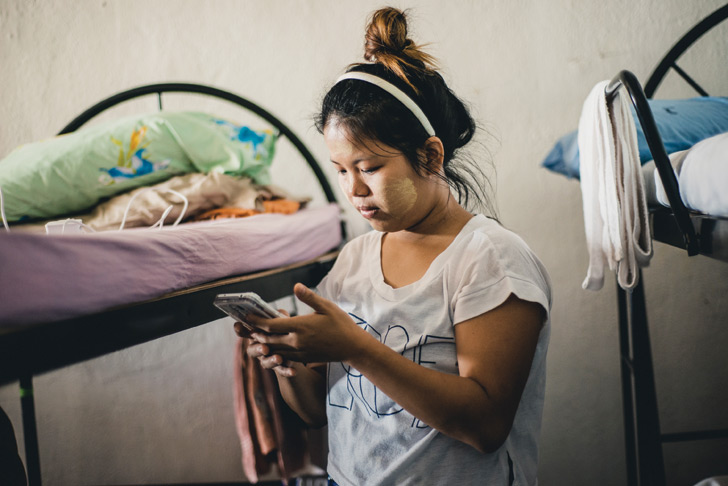Thin, pale scars criss-cross Suppiah Jeyalutchummy’s forearms. “My employers, they took forks or knives and heated them in the gas fire,” she said softly. She gestured to show how her bosses would press the red-hot utensils to her arms. “They would tell me: ‘This is your punishment.’”

The 36-year-old Sri Lankan mother of two, who prefers to be called Jeya, came to Singapore in 2013, joining the ranks of thousands of migrant women who labour in households across the wealthy city-state.
Singapore has a population of about 5.5 million – a formidable number for a country whose land area is only 718.3 square kilometres. Almost 40% of its inhabitants are non-citizens, making immigrants highly visible on the island.
The changing demographic has not gone unnoticed, and migration issues have become a constant bugbear in Singaporean society and politics. Caught by a backlash of discontent among voters – particularly expressed in the 2011 general election where the ruling People’s Action Party turned in its worst performance at the polls – the government has tightened immigration controls. Although the party fared much better in last year’s general election, immigration continues to be a sore point.
The issue is far more complex than a simple dislike of foreigners. “Practically any job can be filled up by a foreign worker. We’re talking about industries including finance, banking, IT, engineering, accountancy and secretarial. Singaporeans are being misplaced in their homeland,” said Gilbert Goh, a vocal opponent of immigration who runs Transitioning, a support service for unemployed Singaporeans.
Migrants on work permits – as opposed to employment passes reserved for foreigners filling white-collar positions – form the greatest proportion of these immigrants. According to the Ministry of Manpower, there are almost one million work permit holders in Singapore. Many of the women are domestic workers, while the men typically work in the construction and shipyard industries, or do public maintenance jobs.
Low-wage migrant workers usually pay recruitment agencies large sums for the opportunity to work in Singapore – domestic workers shell out the equivalent of up to eight months’ salary, while construction workers pay about $7,000. Although many are fortunate to experience the positive sides of Singapore, systemic flaws in the migrant labour economy leaves workers vulnerable to abuse and exploitation. Migrant rights group Home refers up to 2,000 migrant workers a year who have faced various difficulties to the Ministry of Manpower.
“[Migrant workers’] lack of bargaining power is a problem,” said Jolovan Wham, executive director of Home. “Employers don’t establish human resource practices for these workers.”
Foreign domestic workers
Migrant domestic workers are especially vulnerable as they are excluded from Singapore’s Employment Act. As a result, there are no official maximum working hours or overtime provisions. Although the government stipulates that employers are required to give domestic workers one day off a week, this is easily circumvented as employers can financially compensate workers in lieu of their rest day.
Jeya, who arrived in Singapore in 2013, told Southeast Asia Globe that her first employer forced her to work long hours, with days beginning at 4:00am and stretching until midnight. A transfer to a new employer failed to improve her situation; the hours were just as long, and conditions worse.
She was required to travel between three homes during the day, cleaning not just her employer’s home but also that of extended family. There was no day off. Her employer would even deduct SGD200 ($142) out of her SGD350 ($248) salary every month. “For six months I could only send SGD150 [$106] home to my family,” she said. “I was left with nothing for myself.” Unable to endure the situation any longer, Jeya ran away and ended up at Home’s shelter for domestic workers.

Jeya’s story is not unique. According to Wham, Home received 102 reports of physical abuse and 299 reports of emotional abuse from domestic workers last year alone. They also recorded 18 cases of sexual harassment and abuse.
Living alongside Jeya at the shelter, 26-year-old Kim is in limbo while police investigate her case. She first came to Singapore from Myanmar five years ago and worked for several families without incident. But one recent night changed all that.
“I was sleeping but woke up when I felt like there was something near me, and I realised that my male employer had come into my room and got into my bed,” she said, adding that he kept trying to touch her and had locked her in the room.
Eventually, after repeated refusals, he left. The next day, Kim, who preferred not to give her full name, went to the Myanmar embassy for help. She then made a complaint to police and moved into the shelter.
Migrant rights activists have often criticised the live-in requirement for domestic workers. “It makes the worker extremely vulnerable to abuse and exploitation,” said Wham. “In the worst-case scenario, she is isolated from the rest of society.”
However, it is not only female migrant workers who suffer hardships – male migrant workers can also find themselves in tough situations.
A 2015 survey of 605 male migrant workers by the Singapore Management University highlighted issues that could contribute to significant mental and emotional distress for low-wage migrant workers, such as the threat of deportation and debts due to agency fees. While 13% of work permit holders were found likely to suffer from serious mental illness, this jumped to 62% among workers with outstanding injury or salary claims with the Ministry of Manpower.
“We were particularly surprised by the prevalence of emotional distress amongst injured workers,” said assistant professor of sociology Nicholas Harrigan, who co-authored the study. “The high rates of threats of deportation amongst workers with injury and salary claims with the Ministry of Manpower was also worrying. If workers fear deportation, it makes them much less likely to report mistreatment.”
Transient Workers Count Too (TWC2) sees many such cases. Their soup kitchen, known as the Cuff Road Project, serves up a free meal to 300 men each night. Mostly from South Asian countries such as India and Bangladesh, these men are all on Special Passes, a temporary permit issued to migrant workers who have lodged injury or salary claims with authorities.
Statistics on foreign workers
Data collated by project volunteers shows that many of the men have had work injury compensation claims pending for more than six months, during which time they are required to remain in Singapore but denied the right to work. Some have been stuck in the country for over a year, with a small number even waiting for two years or more.
Debbie Fordyce, coordinator of the Cuff Road Project, said it is difficult to predict how long salary claims may take to process. “If it’s cheating or forgery [of contracts or payslips by employers], they may refer it to police. If the police don’t feel it’s their place, they may bounce it back to the Ministry of Manpower, [where] it may be shoved back and forth between departments depending on how the case is interpreted.”
It remains to be seen how much longer Singapore can rely on this system of importing low-wage migrant workers to do the country’s dirty work. Some argue that Singapore will continue to need these workers as long as Singaporeans refuse to take on menial jobs.
“That phrase ‘jobs that citizens don’t want to do’ needs to always be followed by the phrase ‘at the current low rate of pay’,” countered Harrigan. “In other industrialised countries, any of the jobs migrant workers do in Singapore are done by citizens or permanent residents. To get citizens to do such work, however, you need to pay them more.”
“Our foreign work pass framework actively discourages reliance on low-wage and low-skilled foreign workers,” the Ministry of Manpower told Southeast Asia Globe. “For instance, employers pay a higher levy for lower-skilled workers than for higher-skilled ones… At the same time, tighter work pass controls since 2010 encourage all firms to shift towards more manpower-lean methods.”
Yet until this translates into practice, migrant workers will continue to fill the gap, and the most that can be hoped for is that employers treat them fairly.
Jeya recently began working for a Punjabi family who treat her well. There was a hiccup when it came to renewing her work permit – her previous employer tried to get her blacklisted with the Ministry of Manpower – but her new employers appealed on her behalf. On the day she spoke to Southeast Asia Globe, Jeya was finally able to leave the shelter, returning to her new employer.
“They increased my salary too,” she said, visibly relieved at her change in fortunes and bearing no grudge against the city-state despite enduring nightmarish conditions. “This is why I came to Singapore. Singapore is very nice and very good.”


